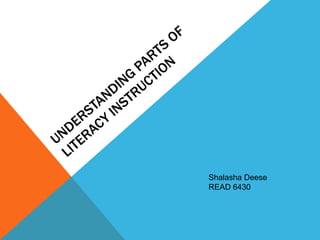
Read6430 inservice presentation s deese
- 2. “What we already know determines to a great extent what we will pay attention to, perceive, learn, remember, and forget.” (Woolfolk, 1998)
- 3. WORKSHOP GOALS: ∙To understand the difference between phonological awareness, phonemic awareness, and phonics ∙ To become familiar with the five levels of phonological awareness ∙ Learn new methods to increase and enhance listening comprehension of narratives and expository texts
- 4. PHONOLOGICAL AWARENESS… ∙ Is the conscious sensitivity to the sound structure of language. ∙ Includes the ability to auditory distinguish parts of speech, such as syllables and phonemes. ∙ The ability to blend and segment phonemes which is critical to the development of decoding spelling skills. http://en.wikipedia.org/wiki/Phonological_awareness.
- 5. PHONEMIC AWARENESS… ∙ Is a subset of phonological awareness in which listeners are able to distinguish phonemes, the smallest units of sound that can differentiate meaning. ∙ Is the ability to hear the sounds and distinguish between them ∙ Is required prior to trying to learn phonics http://en.wikipedia.org/wiki/Phonemic_awareness
- 6. SO, WHAT IS THE DIFFERENCE? The distinction between phonemic and phonological awareness is often confused since they are interdependent. "Phonological awareness" refers to an awareness that words are made up of sounds which are like interchangeable parts. More specifically, that they consist of syllables, 'onsets and rimes,' and phonemes. This is often taught with word games for rhyming and sound matching . http://en.wikipedia.org/wiki/Phonemic_awareness
- 7. PHONICS… ∙ Refers to an instructional design for teaching children to read. Phonics involves teaching children to connect sounds with letters or groups of letters (e.g., that the sound /k/ can be represented by c, k, or ck spellings). ∙ Requires children to learn connections between letter patterns and the sounds they represent. http://en.wikipedia.org/wiki/Phonics
- 9. 5 LEVELS OF PHONOLOGICAL AWARENESS 1-The size of the phonological unit (e.g., it is easier to break sentences into words and words into syllables than to break syllables into phonemes). 2- The number of phonemes in the word (e.g., it is easier to break phonemically short words such as no, see and cap than snort, sleep or scrap). 3-Phoneme position in words (e.g., initial consonants are easier than final consonants and middle consonants are most difficult). 4- Phonological properties of words (e.g., continuant such as /s/ and /m/ are easier than very brief sounds such as /t/). 5- Phonological awareness challenges. (e.g., rhyming and initial phoneme identification are easier than blending and segmenting.) http://www.ldonline.org/article/6280
- 10. 5 LEVELS OF PHONEMIC AWARENESS 1 – To hear rhymes and alliteration as measured by knowledge of nursery rhymes 2 – To do oddity tasks (comparing and contrasting the sounds of words for rhyme and alliteration) 3 – To blend split syllables 4 – To perform phonemic segmentation (such as counting out the number of phonemes in a word) 5 – To perform phoneme manipulation tasks (such as adding, deleting a particular phoneme and regenerating a word from the remainder.
- 11. PHONEMIC AWARENESS ACTIVITIES ∙ Keep a sense of playfulness and fun, avoid drill and rote memorization. ∙ Use group settings that encourage interaction among children. ∙ Encourage children’s curiosity about language and their experimentation with it. ∙ Allow for and be prepared for individual differences. ∙Make sure the tone of the activity is not evaluative but rather fun and informal. http://www.indiana .edu/~reading/ieo/digests/d119.html
- 12. SUGGESTED TEACHING METHODS ∙ At the preschool level, engage children in activities that direct their attention to the sounds in words, such as rhyming and alliteration games. ∙ Teach students to segment and blend. ∙ Combine training segmentation and blending with instruction in letter- sound relationships. ∙ Teach segmentation and complementary processes ∙ Systematically sequence examples when teaching segmentation and blending. ∙ Teach for transfer to novel tasks and contexts. http://www.indiana .edu/~reading/ieo/digests/d119.html
- 13. QUESTIONS REGARDING PHONOLOGICAL AWARENESS, PHONEMIC AWARENESS OR PHONICS?
- 14. COMPREHENSION Reading comprehension is what allows the reader to interact with the text in a meaningful way. Comprehension of a text turns passive reading into active reading -- from letters and words to characters and contexts. Reading comprehension is the crucial link to effective reading. Harvey, S. and Goudvis, A. (2007). Strategies That Work (Second Edition). York, MA: Stenhouse Publishers.
- 15. WAYS TO INCREASE LISTENING COMPREHENSION OF EXPOSITORY TEXTS ∙ Use K-W-L charts and graphic organizers before, during, and after reading. ∙ Have clue words ∙ Construct well-structured comparative statements both orally and written ∙ Make sure children are familiar with vocabulary ∙ Provide anticipation guides prior to the reading Harvey, S. and Goudvis, A. (2007). Strategies That Work (Second Edition). York, MA: Stenhouse Publishers.
- 16. WAYS TO INCREASE LISTENING COMPREHENSION OF NARRATIVES ∙ Develop the concepts in the text by promoting discussion that ties the concepts to the students' backgrounds ∙ Establish a purpose for listening ∙ Use visual aids while reading aloud to help the students focus attention and to reinforce concepts ∙ Ask questions that promote both literal and interpretive or critical responses Harvey, S. and Goudvis, A. (2007). Strategies That Work (Second Edition). York, MA: Stenhouse Publishers.
- 17. IN CONCLUSION: ∙ Although phonological awareness, phonemic awareness, and phonics are different, they all build upon one another in the foundation of reading. Increasing listening comprehension will in turn build independent comprehension. ∙ Remember to make all reading fun!!!
- 18. Questions or suggestions relating to reading comprehension of expository text and narratives???